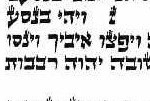Enclosed by reversed “nuns” – B’ha’alot’cha
 A small section of B’ha’alot’cha (Num. 10:35-36) is closed off at each end by a nun hafuchah, a back-facing or inverted form of the Hebrew letter nun meant to denote that this section is out of place.
A small section of B’ha’alot’cha (Num. 10:35-36) is closed off at each end by a nun hafuchah, a back-facing or inverted form of the Hebrew letter nun meant to denote that this section is out of place.
The letter nun may be a technical sign, a forerunner of brackets or parenthesis. Maybe it is a rudimentary drawing of a shofar (Sof’rim 6:1:2). Most people think it is a nun, but it probably has no lexicographical or grammatical significance.
Its shape, not its Hebrew meaning, is what matters, particularly because its hanging spine, easy to draw or engrave, developed a curve. The nun was presumably inverted so as not to give the impression that it had to be pronounced n.
If our verses really belong elsewhere, Saul Lieberman quotes three rabbinic suggestions:
• Rav Ashi says the verses belong to the section of the Torah that describes the banners or standards carried during the Israelite journeys.
• Chizkuni places the clutch of verses after Num. 10:21.
• Rabbenu Bachya and the Baal HaTurim associate them with Num. 11:17.
It is likely, however, that these verses are a chorus linked with the movements of the Israelites in the wilderness (Num. 33). Whenever the people set out, each journey was commemorated by a chorus comprised of Num. 10:35-36, declaimed or chanted to mark the beginning (Vayehi bin’so’a ha’aron) and end (Uv’nucho yomar) of each journey.
In each case, Moses asks God to overcome the hostile tribes in the wilderness and then sings His praises for doing so.



